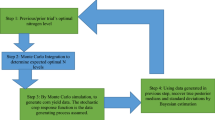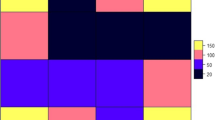Summary
Methods of estimating Smith's b and, thereby, optimum plot size are compared from a theoretical viewpoint. For estimating b, generalized least squares is recommended over Smith's (1938) original method and other methods because the points used to fit the required regression are correlated and have unequal variances.
Optimum plot size for once-over-harvest trials measuring yield (as number of fruits per plot) of pickling and frest-market cucumbers (Cucumis sativus L.) was estimated to be 0.7 to 3.8 m2 (0.5 to 2.5 m of row for rows 1.5 m apart) for conventional harvesting, and 1.0 to 5.6 m2 (0.7 to 3.7 m of row) for simulated harvesting using paraquat to defoliate plots before evaluation. Estimates of optimum plot size were calculated from a number of uniformity trials differing in year (1982 or 1983), planting date (early or late), and field. The estimates were sufficiently stable to suggest that they have useful generality.
For multiple-harvest yield trials, optimum plot sizes for determining yield of pickling (expressed in $/ha or q/ha) or fresh-market cucumbers (i.e. USDA Fancy and No. 1 grade fruit combined or USDA Fancy, No. 1, and No. 2 grade fruit combined, in q/ha) were estimated from experimental data to be 6.4 to 10.3 m2 (4.3 to 6.8 m of row).
Similar content being viewed by others
References
Aitken, A. C., 1935. On least squares and linear combination of observations. Proc. Roy. Soc. Edinburgh 55: 42–48.
Binns, M. R., 1982. The choice of plot size in randomized block experiments. J. Amer. Soc. Hort. Sci. 107: 17–19.
Brim, C. A. & D. D., Mason, 1959. Estimates of optimum plot size for soybean yield trials. Agron. J. 55: 197–199.
Hatheway, W. H. & E. J., Williams, 1958. Efficient estimation of the relationship between plot size and the variability of crop yields. Biometrics 14: 207–222.
Koch, E. J. & J. A., Rigney, 1951. A method of estimating optimum plot size from experimental data. Agron. J. 43: 17–21.
Miller, C. H. & G. R., Hughes, 1969. Harvest indices for pickling cucumbers in once-over harvest systems. J. Amer. Soc. Hort. Sci. 74: 485–487.
Pearce, S. C., 1976. An examination of Fairfield Smith's law of environmental variation. J. Agr. Sci. 87: 25–32.
Searle, S. R., 1966. Matrix Algebra for the Biological Sciences. John Wiley & Sons, New York, pp. 296.
Smith, H. F., 1938. An empirical law describing heterogeneity in the yield of agricultural crops. J. Agr. Sci 28: 1–23.
Smith, O. S. & R. L., Lower, 1978. Field plot techniques for selecting increased once-over harvest yields in pickling cucumbers. J. Amer. Soc. Hort. Sci. 103: 92–94.
Wehner, T. C., T. J., Monaco, & A. R., Bonanno, 1984. Chemical defoliation of cucumber vines for simulation of once-over harvest in small-plot yield trials. HortScience 19: 671–673.
Author information
Authors and Affiliations
Rights and permissions
About this article
Cite this article
Swallow, W.H., Wehner, T.C. Optimum plot size determination and its application to cucumber yield trials. Euphytica 35, 421–432 (1986). https://doi.org/10.1007/BF00021850
Received:
Issue Date:
DOI: https://doi.org/10.1007/BF00021850




